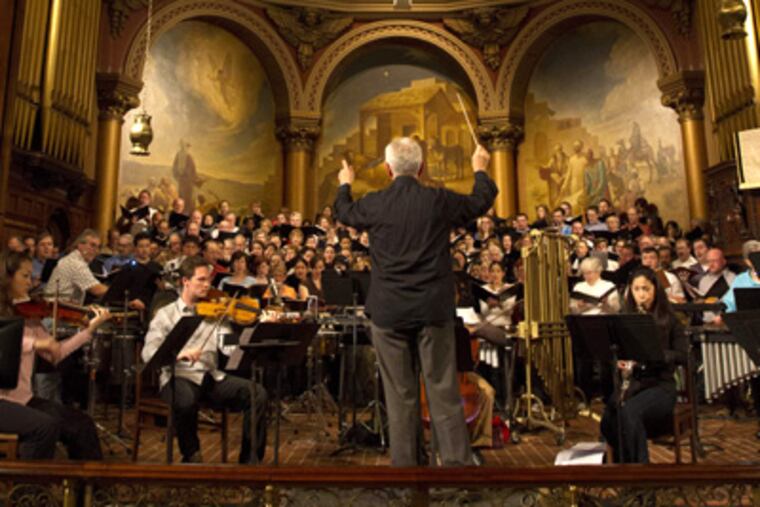Andrea Clearfield’s songs from high mountains
Surveying a battery of Tibetan percussion that had been transported down Himalayan mountains on horseback, Mendelssohn Club music director Alan Harler had to admit he could not really predict what he was about to hear as 200 singers assembled onstage for rehearsal with the Chamber Orchestra of Philadelphia.

Surveying a battery of Tibetan percussion that had been transported down Himalayan mountains on horseback, Mendelssohn Club music director Alan Harler had to admit he could not really predict what he was about to hear as 200 singers assembled onstage for rehearsal with the Chamber Orchestra of Philadelphia. Yet any apprehension about Andrea Clearfield's new choral work, Tse Go La (At the threshold of this life), to be premiered Sunday at Church of the Holy Trinity, was short-lived.
The warm, direct music Philadelphians have come to expect from Clearfield, who teaches composing at University of the Arts, has become all the more distilled as it is increasingly influenced by travels to the loftiest regions of Tibet, where she collected folk music and Buddhist songs in 2008 and 2010. Tse Go La is the most elaborate work to emerge so far from these experiences.
If Clearfield seemed remarkably cool at Thursday's rehearsal — the first with massed forces — she's used to birthing long, large works. This one was only supposed to be 10 minutes long but came out to 35. (As if she's a 10-minute composer!)
"They knew they were going to get more for their money," she said with a laugh.
As will audiences on Sunday — the premiere comes with preperformance dances from a dozen members of the Tibetan Association of Philadelphia. And that's just the first half of the program, called "Rituals: East/West"; the second is the beloved Faure Requiem with the Mendelssohn Club and the Pennsylvania Girlchoir, which not only performs in the Clearfield piece but is its co-commissioner. (The piece already is scheduled for a New York City premiere May 19 at St. Paul the Apostle Church by Schola Cantorum on the Hudson.)
Clearfield rarely writes a large new work without an even larger idea. Tse Go La, she says, "is about rites of passage, what do you hold on to and what do you let go of."
From her pocket, she produces a jet-black seashell fossil that she found in a Tibetan riverbed; it dates back 150 million years, to when the Himalayas were (hard to imagine) underwater. So another concept informing her composing was "the play between time and timelessness."
Of the piece's six sections, the texts of the first ("Birth") and last ("Death") were written by anthropologist and Tibetan medicine expert Sienna Craig. The four other sections have traditional Tibetan text, transliterated so the singers could more correctly pronounce the words. That was painstaking, but in some languages the mere sounds of the words are thought to have spiritual power.
"You can tell that Tibetan culture captured her heart," said Harler of Clearfield.
But it wasn't easy: The focal point of Clearfield's research was the provincial capital of Lo Monthang, accessible only by four days on foot or on horseback. In 2008, her horse was temperamental; in 2010 she walked, and a horse carrying the instruments she collected took off down the mountain and had to be retrieved by one of the guides.
Though she had meant to record only the music that threatens to die with Tashi Tsering, the last remaining royal court singer in the Buddhist monastery there, townspeople came forth offering to have their own "common songs" recorded. She came back with 130 in all; four turn up in Tse Go La.
Though Americans think of folk music as simple and basic, like "Kumbaya," the music of more isolated cultures exists outside the usual rules of melodic and rhythmic symmetry, and in ancient scales that often have what westerners call microtonal pitch relationships. Once back in Philadelphia and transcribing the music in western notation, Clearfield could only say she was as accurate as possible: "I tried to be true to the [vocal] ornament and changes in pitch."
In order to create a meeting place between the two cultures, she created a prerecorded electronic music track including sounds she recorded in Tibet — some musical, some of nature — often melded to create an ambient effect. Yet there's always the danger that the specific Tibetan subtleties will be lost amid the voices and instruments of a western ensemble. With some relief, Clearfield listened to the Mendelssohn Club and Pennsylvania Girlchoir rehearsing and said, "The songs are very much as I heard them."
Contact David Patrick Stearns at dstearns@phillynews.com.
Music Rituals: East/West 4 p.m. Sunday at the Church of the Holy Trinity, Rittenhouse, 1904 Walnut St. Tickets: $28. www.mcchorus.org